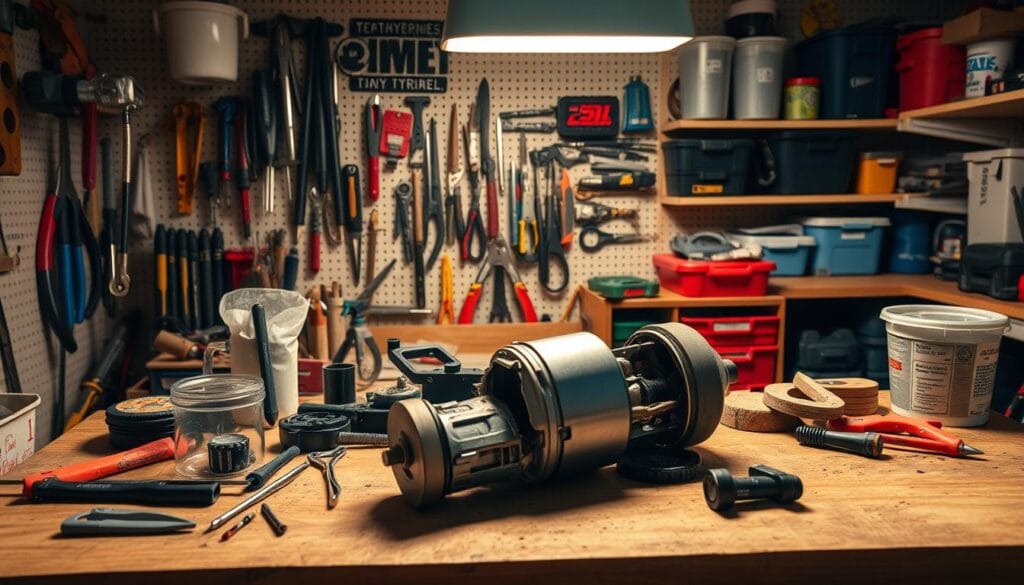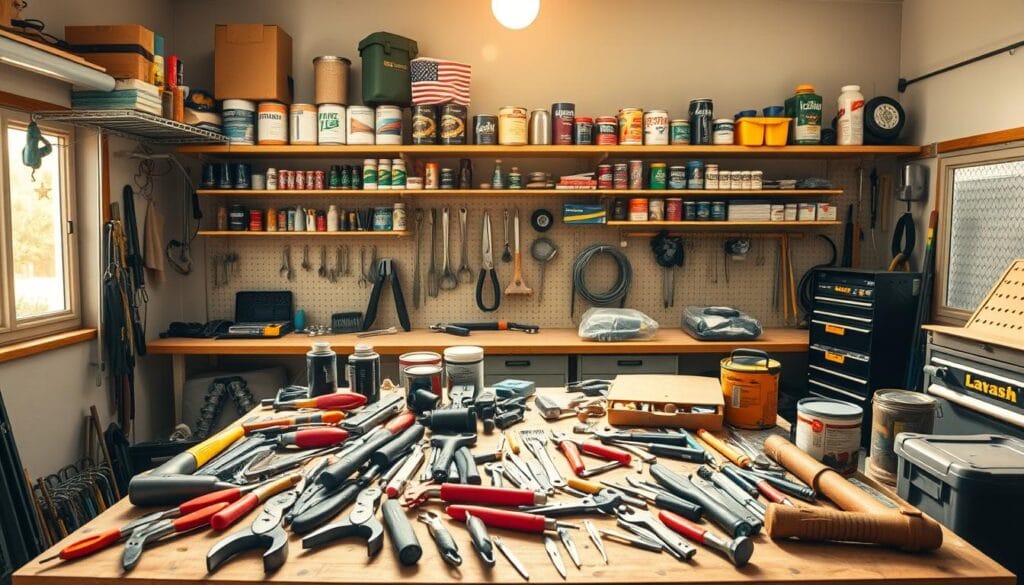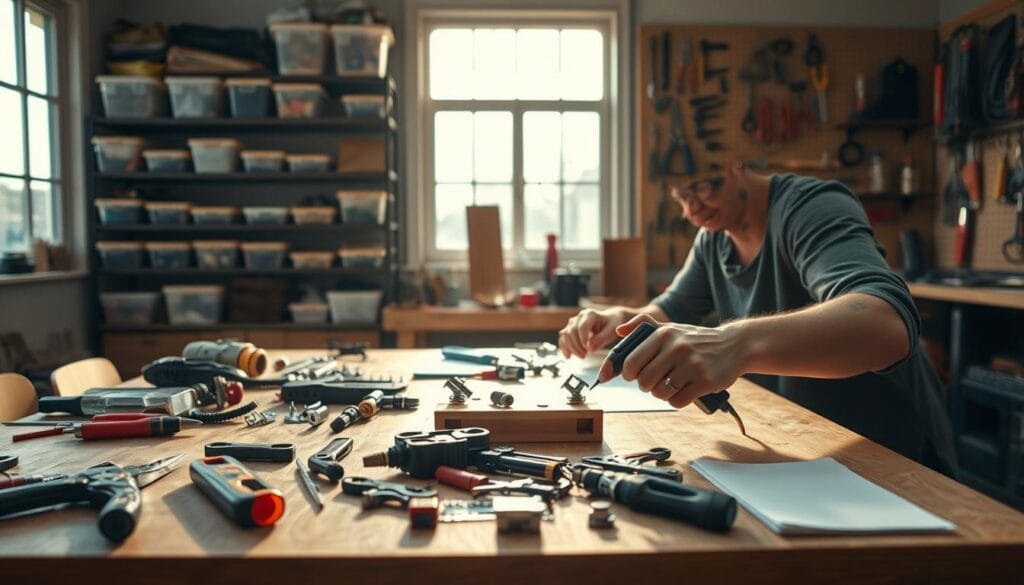Easily Fix-Change or Repair Everyday Problems, Did you know about 10% of homeowners face small plumbing issues like clogged drains or leaky faucets often? You can tackle these problems with basic DIY skills and solutions, saving up to 75% on repair costs. Simple home maintenance can boost your home’s efficiency and lifespan. It can also cut energy use by about 15% with the right weather stripping.
Home repair hacks can save you a lot of time and money. Many common issues can be fixed without calling a professional. For example, to clear a clogged drain, just pour ½ cup of baking soda, then ½ cup of white vinegar, and wait 30 minutes to an hour. You can also fix wooden furniture scratches with clear nail polish, making it look new again.

Easily Fix-Change or Repair Everyday Problems, Key Takeaways
- You can save up to 75% on repair costs by utilizing DIY skills and solutions.
- Simple home maintenance strategies can enhance household efficiency and longevity.
- DIY fixes can save each household up to $500 annually.
- Properly installed weather stripping can improve energy efficiency by approximately 15%.
- Using baking soda and vinegar can effectively unclog drains and address grease and grime.
- Learning DIY skills can help you troubleshoot and repair everyday problems, reducing the need for professional intervention.
Understanding the Basics of DIY Repairs
DIY repairs need the right tools and knowledge. A good home repair toolkit costs between $100 and $300. This can save you a lot of money, as DIY projects can cut costs by 50% to 70% compared to hiring pros.
Before starting any repair, safety is key. Wear gloves and safety glasses and keep the area clear. Knowing how complex the problem is helps you decide what to do. For example, fixing a leaky faucet can save 10% on water bills, but you’ll need some plumbing skills and tools.
Common DIY projects include unclogging drains, changing light fixtures, and refinishing floors. Online tutorials and guides can help. By following these and being safe, you can save money and feel proud of your work.
Regular maintenance prevents future problems. Clean and check your home’s systems and appliances regularly. Doing routine repairs and replacements keeps your home safe and working well.
| Project | Cost | Time |
|---|---|---|
| Unclogging drains | $100-$300 | 1-2 hours |
| Replacing light fixtures | $150-$500 | 1-2 hours |
| Refinishing hardwood floors | $100-$500 | 4-48 hours |
Understanding DIY repairs and being safe can save you money and make you feel accomplished. Always follow tutorials and guides. And don’t forget to keep up with regular maintenance to avoid future issues.
The Mindset of Successful DIY Problem Solving
DIY problem solving needs the right mindset. A step-by-step guide helps you solve problems logically. But, being patient and persistent is key.
https://youtube.com/watch?v=XWN5B4EGsfI projects with confidence.
Most household problems can be fixed with basic tools and knowledge. Adopting a DIY mindset saves money and boosts self-reliance. Here are some benefits:
- Develops problem-solving skills and critical thinking
- Saves money on repairs and maintenance
- Increases sense of accomplishment and self-reliance
- Enhances creativity and resourcefulness
By following a step-by-step guide and staying patient, you can tackle any challenge. The key is to solve problems logically and be open to learning. This mindset helps you succeed in home improvement and maintenance.
With the right mindset and practice, anyone can become a skilled DIY problem solver. They can reach their goals in home improvement and maintenance.
| Benefits of DIY Problem Solving | Description |
|---|---|
| Develops problem-solving skills | Enhances critical thinking and resourcefulness |
| Saves money on repairs | Reduces maintenance costs and increases self-reliance |
| Increases sense of accomplishment | Boosts confidence and self-esteem |
How to Fix, Change, or Repair Things: A Systematic Approach
Fixing, changing, or repairing things can be easier with a systematic approach. A repair guide helps by offering a step-by-step process. This way, you can handle many DIY projects confidently and accurately.
Finding the root cause of a problem is crucial. You need to gather information and eliminate possibilities to find the issue. Once you know what’s wrong, you can get the right materials and tools. A repair guide is very helpful here, giving you a clear plan to follow.
Easily Fix-Change or Repair Everyday Problems, Key Steps in the Repair Process
- Identify the root cause of the problem
- Gather the required materials and tools
- Follow a step-by-step repair guide to fix the issue
- Test your solution to make sure it works
By following these steps, fixing things becomes easier. Always use a repair guide and fixing hacks for help. With time and practice, you’ll get better at DIY projects.
Using a systematic approach saves time and money. It also helps you learn new skills and become more independent. So, when you need to fix something, try it yourself. With the right approach and practice, you can become a DIY expert.
| Problem | Solution |
|---|---|
| Leaky faucet | Replace worn-out washer or gasket |
| Clogged drain | Use a plunger or plumbing snake to clear blockage |
| Broken light switch | Replace switch with new one |
Common Household Repairs Made Simple
Learning simple DIY repairs can save you time and money. You can fix leaky faucets and unclog drains easily with the right maintenance and tutorial. About 20% of American homes face plumbing issues every year. This makes fixing leaks and clogs very common.
A leaky faucet can waste up to 3,000 gallons of water yearly. This can cost you around $30 in water bills each year. By doing DIY repairs, you can save money and help the environment. Some common repairs include:
- Fixing leaky faucets
- Unclogging drains
- Replacing light switches
These tasks can be done with basic tools and a bit of patience. For instance, replacing a light switch can take under 30 minutes. It can also save you $75 to $150 in labor costs. By following a simple DIY tutorial and doing regular maintenance, you can keep your home in great shape. This way, you can avoid expensive repairs.

Remember, DIY repairs are not only good for your wallet but also for the planet. By using reusable tools and materials, you can cut down on chemical use and waste. With practice and patience, you can master many DIY repairs and maintenance tasks. This makes you a more self-sufficient homeowner.
Easily Fix-Change or Repair Everyday Problems, Smart Troubleshooting Techniques for Better Results
To get better at home improvement, learning smart troubleshooting is key. Troubleshooting helps you fix problems quickly and saves money. It’s a step-by-step process that makes solving issues easier.
There are many ways to troubleshoot. Start with a visual inspection to spot obvious problems. You can also listen for unusual sounds that might mean something’s wrong. For tougher issues, digital tools can be very helpful.
- Identifying the root cause of the problem
- Gathering all necessary information and tools
- Testing your solution to ensure it works
By following these steps and using smart troubleshooting, you’ll get better at home improvement. Always follow a step-by-step guide. Troubleshooting is a way to learn and grow your skills.
Easily Fix-Change or Repair Everyday Problems, Maintenance Tips to Prevent Future Problems
Regular maintenance is key to avoiding future issues and making your belongings last longer. Simple maintenance tips can save you money and cut down on waste. For example, using the right lubricants and seals can prevent many common problems.
Some important maintenance tasks include:
- Checking and replacing caulk every 5 years
- Cleaning home siding twice a year
- Performing gutter maintenance at least twice a year
- Inspecting your roof twice a year
Also, regular maintenance checklists can help you keep track of tasks. You can do this on a monthly, yearly, or biennial basis. This can lead to big savings. By spending time on maintenance, you can avoid expensive repairs and keep your home in top shape.
A well-kept home can keep up to 10% of its value. Plus, simple actions like running a ceiling fan the right way in winter can cut heating costs by up to 10%. By following these tips and using a repair guide, you can avoid future issues and enjoy a safe, comfy home.
| Maintenance Task | Frequency |
|---|---|
| Check and replace caulk | Every 5 years |
| Clean home siding | Twice a year |
| Perform gutter maintenance | At least twice a year |
| Inspect roof | Twice a year |
Easily Fix-Change or Repair Everyday Problems, When to DIY vs. When to Call a Professional
Thinking about fixing something yourself? It’s key to think about the good and bad of DIY versus getting a pro. DIY can save money, but it’s important to know the risks. For example, if it’s something like a bad electrical system, it’s safer to get a pro to avoid danger.
Here’s a simple rule: compare the repair cost to buying a new one. If fixing it costs more than half of a new one, it’s cheaper to buy new. Also, think about the downsides of DIY, like making things worse or not solving the problem right. To decide wisely, use a DIY repair checklist:
- Check how hard the problem is
- Look up what you need to fix it
- Think about the risks and costs
By being careful and methodical, you can lower risks and get it right. Always be safe and avoid accidents. With the right attitude and skills, you can fix many things, like a leaky faucet or change your home’s look.
Also, remember how long things last in your home and keep them in good shape. For example, dishwashers last about 9 years, and fridges up to 13. Keeping up with maintenance and fixing problems fast can make your appliances last longer and save you money. | Appliance | Typical Lifespan | | — | — | | Dishwasher | 9 years | | Refrigerator | 13 years | | Stove | 13-15 years | | Furnace | 15-20 years | | Air Conditioner | 15 years |
Easily Fix-Change or Repair Everyday Problems, Building Your DIY Confidence Through Practice
As you keep working on DIY projects, you’ll see your skills and confidence grow. Start with simple projects to build a solid base. Then, you can tackle more challenging tasks. Maintenance is key too, as it keeps your projects in top shape and helps you develop a routine.
A DIY tutorial is a great tool to kick off a new project. These guides offer step-by-step advice and tips to tackle common issues. Remember, DIY repair is a journey that requires patience and persistence.
Here are some tips to boost your DIY confidence:
- Begin with easy projects and then move to harder ones
- Regular maintenance helps you stay on track and keeps your projects in order
- DIY tutorials are a great resource for starting new projects
- Stay patient and keep going when faced with DIY repair challenges

By sticking to these tips and keeping at DIY projects, you’ll grow more confident. Always be patient and don’t hesitate to seek help when needed.
| Project Type | Difficulty Level | Recommended Tools |
|---|---|---|
| Simple DIY project | Beginner | Basic toolkit |
| Intermediate DIY project | Intermediate | Specialized toolkit |
| Advanced DIY project | Advanced | Professional-grade toolkit |
Conclusion: Empowering Yourself to Tackle Any Challenge
Learning to be a confident DIY expert starts with the right mindset. You need essential skills and a method for solving problems. By using the tips given, you can handle many everyday issues, from simple tasks to big projects.
Starting your journey to self-reliance comes with its hurdles. But these challenges are chances to grow and learn. Always be open to learning, even from mistakes. This way, you’ll get better at solving problems and feel more confident.
Surround yourself with people who love DIY and solving problems. They can offer advice, share their wins, and inspire you. Together, you can create a community that helps each other grow and make a difference.
Start this journey with excitement and a strong will to succeed. By being resourceful and adaptable, you’ll open doors to new possibilities. Every problem becomes a chance to grow and innovate. Embrace this journey and watch your skills and confidence grow.
FAQ
What essential tools do I need to become a successful DIY enthusiast?
To be a DIY pro, you need the right tools. Start with a good toolbox, screwdrivers, pliers, a hammer, and a measuring tape. Don’t forget a level and a utility knife. These basics will help you succeed in DIY projects.
How can I assess the complexity of a repair or maintenance task?
First, inspect the problem carefully. Look for the root cause. Then, think about the tools and skills you need. Also, consider the risks and time it might take.
This will help you decide if you can do it yourself or need a pro.
What is the most important mindset for successful DIY problem-solving?
To solve DIY problems well, you need the right mindset. Be patient, persistent, and open to learning from mistakes. Embrace challenges and try new things. This way, you’ll enjoy tackling tough projects.
What is the systematic approach to fixing, changing, or repairing things?
Fixing things needs a plan. First, find the problem’s cause. Then, get all the tools and materials you need. Finally, test your fix before you’re done.
This method helps you handle DIY projects with confidence and precision.
What are some common household repairs that can be easily done at home?
You can fix many household problems yourself. For example, unclog drains with baking soda and vinegar. Fix leaky faucets and repair wooden furniture scratches with clear nail polish.
Learning these simple fixes saves time and money, and reduces the need for professionals.
What are some smart troubleshooting techniques for better DIY results?
Good troubleshooting is key to DIY success. Start by visually inspecting the problem. Look for wear and tear or damage. Listen for unusual sounds to find the issue.
Digital tools like multimeters or borescopes can also help.
How can I prevent future problems through proper maintenance?
Keeping things in good shape prevents future problems. Simple tasks like lubricating parts, sealing gaps, and cleaning regularly help a lot. A regular maintenance routine saves time and money and avoids unexpected issues.
When should I DIY versus call a professional for a repair or maintenance task?
Decide if you should DIY or call a pro based on the task’s complexity and risks. For simple repairs or maintenance, DIY is best. But for complex or dangerous tasks, a pro is safer and more reliable.
How can I build my DIY confidence through practice?
Building DIY confidence takes practice. Start with simple tasks like replacing a light bulb. As you get better, take on harder projects. Always remember safety first.
With time and experience, you’ll grow more confident in your DIY skills.






[…] for instance, breaks down sugars in the dough to produce carbon dioxide. Baking powder, on the other hand, releases gas when it meets liquid and […]
Your insights are like a perfectly mixed track! Have you explored Sprunki? It’s where creativity knows no limits.